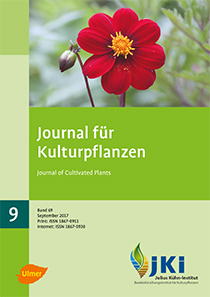Characterisation of <em>Alternaria radicina</em> isolates and assessment of resistance in carrot (<em>Daucus carota</em> L.)
DOI:
https://doi.org/10.5073/JfK.2017.09.01Keywords:
Alternaria radicina, A. carotiincultae, A. petroselini, bioassay, carrot, conidia, pathogenicity, resistance, ELISA, PCRAbstract
Alternaria radicina is a fungal pathogen that causes the black rot disease of carrot. Four Alternaria spp. isolates associated with black rot symptoms collected from carrot (Daucus carota) and parsley (Petroselinum crispum) were characterised and differentiated in relation to the closely related Alternaria species A. radicina, A. carotiincultae and A. petroselini belonging to the Alternaria sect. Radicina. The Alternaria isolates were differentiated for their growth rates and colony margins. A typical feature of A. radicina isolates is the production of high amounts of yellow pigments on acidified potato dextrose agar (APDA). Furthermore, sporulation intensity and conidia morphology were determined to classify the potential new A. radicina isolates. The pathogenicity of the Alternaria isolates was determined by bioassays with detached leaves of four Apiaceae species. Different carrot cultivars and one wild relative were used to estimate aggressiveness of the isolates. The disease symptoms were quantified in bioassays using a digital image analysis system (LemnaTec). Additionally, a DAS-ELISA with polyclonal antibodies was used to detect the development of fungal pathogens. As result of the morphological and molecular characteristics as well as the pathogenicity assay, three isolates were verified as A. radicina and one as A. petroselini. Finally, two isolates with different aggressiveness were used to screen a set of 14 carrot genotypes for resistance to A. radicina.
Published
Issue
Section
License
The content of the journal is licensed under the Creative Commons Attribution 4.0 License. Any user is free to share and adapt (remix, transform, build upon) the content as long as the original publication is attributed (authors, title, year, journal, issue, pages).
The copyright of the published work remains with the authors. The authors grant the Journal of Cultivated Plants, the Julius Kühn-Institut and the OpenAgrar repository the non-exclusive right to distribute and exploit the work.







